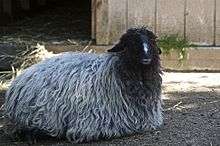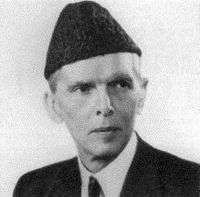Karakul sheep

Karakul or Qaraqul (named after Qorako‘l, a city in Bukhara Province in Uzbekistan) is a breed of domestic sheep which originated in Central Asia. Some archaeological evidence points to Karakul sheep being raised there continuously since 1400 BC.[1]
Hailing from the desert regions of Central Asia, Karakul sheep are renowned for their ability to forage and thrive under extremely harsh living conditions. They can survive severe drought conditions because of a special quality they have, storing fat in their tails. Karakul are also raised in large numbers in Namibia, having first been brought there by German colonists in the early 20th century.
Use by humans

Karakul sheep are a multi-purpose breed, kept for milking, meat, pelts, and wool. As a fat-tailed breed, they have a distinctive meat. Many adult Karakul are double-coated; in this case, people separate the coarse guard hair from the undercoat. Karakul is relatively coarse fiber used for outer garment, carpets and for felting.
Karakul pelts
Very young or even fetal Karakul lambs are prized for pelts. Newborn karakul sheep pelts are called karakul (also spelled caracul), swakara (coined from South West Africa Karakul), astrakhan (Russian), Persian lamb, agnello di Persia, (Italian), krimmer (Russian) and garaköli bagana (Turkmen). Sometimes the terms for newborn lambs' and fetal lambs' pelts are used interchangeably.[2] The newborn lambs have a tight, curly pattern of hair. The lambs must be under three days old when they are killed, or they will lose their black color and soft, tightly wound coils of fur.[3] Dark colors are dominant and lambs often darken in color as they age. Fetal karakul lamb pelts are called broadtail, Breitschwanz (German), and karakulcha. Fetal karakul lambs are harvested through miscarriages, induced early delivery or by killing the mother sheep and removing the fetus.[4] Rather than killing healthy female sheep, farmers will kill older sheep that have already given birth many times.[4] People use the lamb pelts to create various clothing items, such as The Astrakhan (hat) or karakul hat.[5] The pelts have also been used in haute couture.[6][7]
See also
- Karakul (hat)
- Montera Spanish bullfighter's hat
References
- ↑ "Karakul". Breeds of Livestock. Oklahoma State University, Dept. of Animal Science. Retrieved 2009-04-17.
- ↑ "HSUS Investigation: Karakul Sheep and Lamb Slaughter for the Fur Trade" (PDF). The Humane Society of the United States. March 2001 [July 2000]. Retrieved 2009-04-17.
- ↑ "Karakul Sheep: Bright-eyed and Broad-tailed". Hobby Farms. Retrieved 25 June 2016.
- 1 2 Wilson, Eric (11 August 2005). "The Lamb on the Runway". New York Times. Retrieved 25 June 2016.
- ↑ Associated Press (April 24, 2002). "Hamid Karzai's Famous Hat Made From Aborted Lamb Fetuses". Fox News. Retrieved 2009-04-17.
- ↑ "Astrakhan: Hot "New" Fashion is the Same Old Cruelty". The Humane Society of the United States. August 12, 2005. Retrieved 2009-04-17.
- ↑ Associated Press (May 27, 2007). "Karakuls burst upon the fashion world". Taipei Times. Retrieved 2009-04-17.
External links
-
 Media related to Karakul (sheep) at Wikimedia Commons
Media related to Karakul (sheep) at Wikimedia Commons - American Karakul Sheep Registry